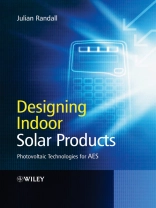Photovoltaic technology – or the direct conversion of light into
electricity – is the fastest growing means of electricity
generation today, however it is generally used outdoors. Relatively
little attention has been focused on the many obstacles to overcome
when designing efficient indoor products. As a result, indoor
products are more often than not limited to low power. Designing
Indoor Solar Products bridges this gap by showing where AES
(Ambient Energy Systems) based on photovoltaic cells may be used
for higher power devices.
Motivated by both financial and ecological arguments, this
book:
* Co-ordinates a wide-reaching range of scientific information
regarding photovoltaic technologies and their application to indoor
spaces.
* Analyses power management, power availability, technological
selection and design methodologies.
* Uses real-life examples and case studies to demonstrate the
arguments made.
* Presents information in such a way as to make it accessible
even to engineers with basic electrical knowledge.
Designing Indoor Solar Products pulls together a wealth
of information on photovoltaic technologies and their applications.
It will be of practical interest to engineers and designers of
sensor systems planning on using photovoltaic technology for power,
whilst the theoretical approach will appeal to those in academia in
the related areas of environmental engineering, sustainable
development as well as building and product design.
electricity – is the fastest growing means of electricity
generation today, however it is generally used outdoors. Relatively
little attention has been focused on the many obstacles to overcome
when designing efficient indoor products. As a result, indoor
products are more often than not limited to low power. Designing
Indoor Solar Products bridges this gap by showing where AES
(Ambient Energy Systems) based on photovoltaic cells may be used
for higher power devices.
Motivated by both financial and ecological arguments, this
book:
* Co-ordinates a wide-reaching range of scientific information
regarding photovoltaic technologies and their application to indoor
spaces.
* Analyses power management, power availability, technological
selection and design methodologies.
* Uses real-life examples and case studies to demonstrate the
arguments made.
* Presents information in such a way as to make it accessible
even to engineers with basic electrical knowledge.
Designing Indoor Solar Products pulls together a wealth
of information on photovoltaic technologies and their applications.
It will be of practical interest to engineers and designers of
sensor systems planning on using photovoltaic technology for power,
whilst the theoretical approach will appeal to those in academia in
the related areas of environmental engineering, sustainable
development as well as building and product design.
Cuprins
About the author.Preface.
Acknowledgements.
Introduction.
1. State of the Art.
Introduction.
Low Power Energy Sources.
Intellectual Property Rights.
IPV Taxonomies.
IPV gaps in knowledge.
Conclusion.
2. Engineering design.
Introduction.
Defining design.
Trends in engineering design.
Life Cycle Methods.
Conclusion.
3. Radiant Energy Indoors.
Introduction.
Physics of buildings.
Photometric characterisation.
Radiometric characterisations.
Computer simulation.
Discussion.
Conclusion.
Future work.
Further reading.
4. Fundamentals of Solar Cells.
Introduction.
A brief history of solar collectors and PV.
Photonic semiconductors.
Photovoltaic Technology.
Suboptimal solar cell efficiency.
IPV Material Technologies.
Efficiency improvements.
Conclusion.
Further reading.
5. Solar Cells for Indoor Use.
Introduction.
Technology performance at indoor light levels.
Indoor light level model presentation.
Discussion.
Designing PV modules for indoor use.
Conclusion.
Further work.
6. Indoor Ambient Energy Charge Storage.
Introduction.
Trends in charge storage.
Charge storage technology.
Charge storage parameters.
To determine storage capacity.
Electrochemical Storage Technologies.
Conclusion.
Future Work.
Further reading.
7. Ambient Energy Power Source Design.
Introduction.
Clarification.
Conceptual Design.
Embodiment.
Detailed Design.
Case studies.
Conclusion.
Further reading.
Conclusion.
Abbreviations and Symbols.
Glossary.
References.
Index.
Despre autor
Dr. Julian Randall is a Senior Research Fellow at the ETHZ(Eidgenossische Technische Hochschulze Zurich), Switzerland. His
Bachelor of Engineering with honours is from University of Wales
College, Cardiff and he holds a doctorate from the EPFL (Ecole
Polytechnique Federale de Lausanne), Switzerland. He is a Chartered
Engineer and a Member of the IEE and IEEE.
Dr. Randall is an active researcher of indoor photovoltaic solar
application, most recently for a wearable autonomous location
tracking system [207]. He is the general chair of the Second
International Forum on Applied Wearable Computing in Zurich,
Switzerland. His research interests include, but are not limited
to, ambient energy power sources, context-aware wearable systems,
autonomous systems and human-computer interfaces. Any queries
should be directed via jfrandall@iee.org.
Limba Engleză ● Format PDF ● Pagini 198 ● ISBN 9780470017142 ● Mărime fișier 2.7 MB ● Editura John Wiley & Sons ● Publicat 2006 ● Ediție 1 ● Descărcabil 24 luni ● Valută EUR ● ID 2312269 ● Protecție împotriva copiilor Adobe DRM
Necesită un cititor de ebook capabil de DRM










